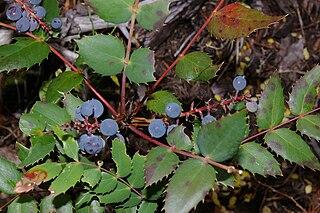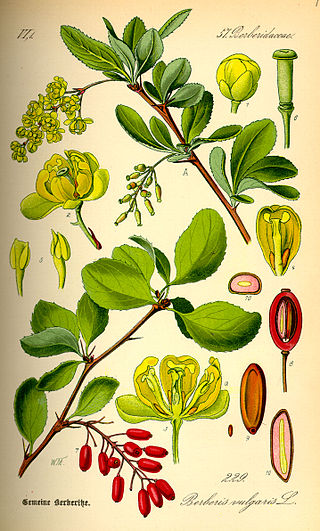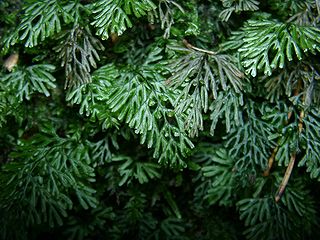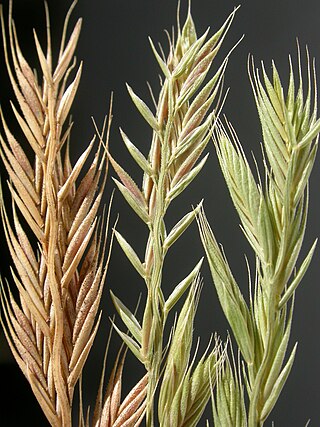
Berberis aquifolium, the Oregon grape or holly-leaved barberry, is a species of flowering plant in the family Berberidaceae, native to western North America. It is an evergreen shrub growing 1–3 meters tall and 1.5 m (5 ft) wide, with pinnate leaves consisting of spiny leaflets, and dense clusters of yellow flowers in early spring, followed by dark bluish-black berries.

Laburnum, sometimes called golden chain or golden rain, is a genus of two species of small trees in the subfamily Faboideae of the pea family Fabaceae. The species are Laburnum anagyroides—common laburnum and Laburnum alpinum—alpine laburnum. They are native to the mountains of southern Europe from France to the Balkans.

Mahonia is a formerly accepted genus of approximately 70 species of shrubs or, rarely, small trees with evergreen leaves in the family Berberidaceae, native to eastern Asia, the Himalaya, North America, and Central America. They are closely related to the genus Berberis and as of 2023 the majority of botanical sources list it as a synonym for Berberis.

Carl Borivoj Presl was a Czech botanist.

Berberis, commonly known as barberry, is a large genus of deciduous and evergreen shrubs from 1–5 m (3.3–16.4 ft) tall, found throughout temperate and subtropical regions of the world. Species diversity is greatest in South America and Asia; Europe, Africa and North America have native species as well. The best-known Berberis species is the European barberry, Berberis vulgaris, which is common in Europe, North Africa, the Middle East, and central Asia, and has been widely introduced in North America. Many of the species have spines on the shoots and all along the margins of the leaves.

Berberis nervosa, commonly known as dwarf Oregon-grape, Cascade barberry, Cascade Oregon-grape, or dull Oregon-grape, is a flowering plant native to the northwest coast of North America from southern British Columbia south to central California, with an isolated population inland in northern Idaho. It is especially common in second growth, Douglas-fir or western redcedar forests, making use of those pools of sunlight that intermittently reach the ground.

Berberis darwinii, Darwin's barberry, is a species of flowering plant in the family Berberidaceae, native to southern Chile and Argentina and naturalized elsewhere. Regional vernacular names include michay, calafate, and quelung. Growing to 3–4 m (9.8–13.1 ft) tall, it is an evergreen thorny shrub.

Berberis vulgaris, also known as common barberry, European barberry or simply barberry, is a shrub in the genus Berberis native to the Old World. It produces edible but sharply acidic berries, which people in many countries eat as a tart and refreshing fruit.

Berberis thunbergii, the Japanese barberry, Thunberg's barberry, or red barberry, is a species of flowering plant in the barberry family Berberidaceae, native to Japan and eastern Asia, though widely naturalized in China and North America, where it has become a problematic invasive in many places, leading to declines in species diversity, increased tick habitat, and soil changes. Growing to 1 m tall by 2.5 m broad, it is a small deciduous shrub with green leaves turning red in the autumn, brilliant red fruits in autumn and pale yellow flowers in spring.

The Hymenophyllaceae, the filmy ferns and bristle ferns, are a family of two to nine genera and about 650 known species of ferns, with a subcosmopolitan distribution, but generally restricted to very damp places or to locations where they are wetted by spray from waterfalls or springs. Fossil evidence shows that ferns of the family Hymenophyllaceae have existed since at least the Upper Triassic.

Allium textile is a common species of wild onion found in the central part of North America.

Berberis oiwakensis is a species of plant in the barberry family, Berberidaceae. It is native to Taiwan, China and Myanmar, where it occurs at elevations of 600 to 3800 m. It has recently been found naturalized in South Africa.

Genista aetnensis, the Mount Etna broom, is a species of flowering plant in the legume family Fabaceae. It is a large shrub or small tree endemic to Sicily and Sardinia where it is associated with sunny, open landscapes and poor, stony soil. It is a very common constituent of the garigue plant communities, Mediterranean shrubby vegetation, around the lower slopes of Mount Etna, hence its Latin specific epithet aetnensis.

Vulpia is a widespread genus of plants in the grass family, native to many countries around the world and naturalized in many of the nations to which it is not native. It is most common in temperate regions.

The South Apennine mixed montane forests is an ecoregion in the southern Apennine Mountains of southern Italy and Sicily. It has a Mediterranean climate, and is in the Mediterranean forests, woodlands, and scrub biome.
Berberis chochoco is an evergreen shrub or small tree up to 9 m (30 ft) tall, in the genus Berberis, family Berberidaceae. It is native to mountainous regions of northeastern Mexico, in the states of Nuevo León, Veracruz, and San Luis Potosí.

Berberis haematocarpa, Woot. with the common names red barberry, red Mexican barbery, Colorado barberry and Mexican barberry, is a species in the Barberry family in southwestern North America. It is also sometimes called algerita, but that name is more often applied to its relative, Mahonia trifoliolata.
Solenopsis is a genus of plants in the Campanulaceae. It is native to the Mediterranean region from Portugal and the Canary Islands east to Turkey.
The Botany of Fuegia, the Falklands, Kerguelen's Land, Etc. is a description of the plants discovered in these islands during the Ross expedition written by Joseph Dalton Hooker and published by Reeve Brothers in London between 1845 and 1847. Hooker sailed on HMS Erebus as assistant surgeon. It was the second in a series of four Floras in the Flora Antarctica, the others being the Flora of Lord Auckland and Campbell's Islands (1843-1845), the Flora Novae-Zelandiae (1851–1853), and the Flora Tasmaniae (1853–1859). They were "splendidly" illustrated by Walter Hood Fitch.















